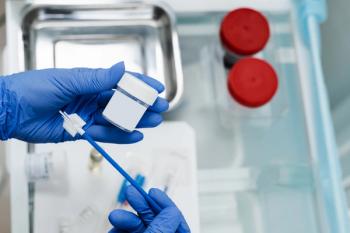
Pharmacists Can Drive Equitable Diagnostics Access, Improve Antimicrobial Resistance Stewardship
Key Takeaways
- Reducing diagnostic barriers is key to achieving health equity, particularly in AMR and STI screening, where disparities are prevalent.
- Pharmacists and healthcare providers play a crucial role in expanding diagnostic access, integrating early detection, and improving outcomes.
Experts outline innovative approaches to reduce inequities in diagnostic access and optimize patient outcomes.
Equity is becoming an increasing concern across the health care system. Implementing equitable practices in health care ensures that every patient can attain their full health potential, even in the face of economic or societal disparities. A key aspect of ensuring health equity is lowering barriers to diagnostic testing, empowering patients to know their health status and seek appropriate care. According to experts during a session at IDWeek 2025, health care providers like pharmacists, physicians, and others across the spectrum are critical players in achieving this goal.1
The experts spoke at a symposium titled Lowering Barriers to Diagnostics Access to Reduce Health Inequities and Improve Outcomes, moderated by Ritu Banerjee, MD, PhD. Panelists included Jacinda Abdul-Mutakabbir, PharmD, MPH, associate professor of clinical pharmacy at the University of California San Diego; Dina Greene, PhD, clinical professor at the University of Washington; and Karissa Culbreath, PhD, D(ABMM), associate clinical professor of pathology at the University of New Mexico Health Sciences Center.1
Each expert highlighted how limited access to diagnostics can exacerbate health disparities, especially in antimicrobial resistance (AMR) and sexually transmitted infection (STI) screening. In implementing solutions to these challenges, pharmacists can play a key role.1
Why Should AMR Diagnostics Expand to Outpatient Settings?
Abdul-Mutakabbir began by emphasizing the global burden of AMR. Approximately 3 million AMR infections occur each year, with resistance evolving due to judicious antimicrobial use during the COVID-19 pandemic. Defying misconceptions, Abdul-Mutakabbir noted that most AMR use occurs in the outpatient setting, even though AMR infections are typically discussed in the context of health care–acquired infections.1
Inequities abound in AMR infections. Numerous research initiatives have uncovered inequities in AMR infections, with a higher likelihood of infection in racially and ethnically minoritized (REM) individuals, those residing in areas of low socioeconomic status, and people who speak a language other than English. According to Abdul-Mutakabbir, these inequities have been purported by social determinants of health and bolstered by systems of oppression. An individual’s education, socioeconomic status, and access to timely health services can greatly impact AMR.1-4
"If you have a health care provider shortage, you don't have an access point to receive care,” Abdul-Mutakabbir said.1
Abdul-Mutakabbir explained the vicious cycle of AMR infections using the example of urinary tract infections (UTIs), which she and her team studied in a research initiative at her institution. This research confirmed that REM UTI patients were more likely to live in an area with high social vulnerability and chronic illness. Correspondingly, other investigators have found that patients and providers incur immense increased costs due to AMR UTIs, with an approximate $2000 cost increase due to AMR UTI compared with a UTI caused by a susceptible pathogen.1,5,6
In this vein, collaboration between pharmacists and physicians to integrate diagnostics into outpatient AMR efforts is crucial. Abdul-Mutakabbir said it was critical to employ early detection of resistant microbes and prescribe prompt and appropriate treatment, which could reduce the societal and economic burden of AMR while improving outcomes across the board. She also noted the essential need to integrate diagnostic tools alongside AMR stewardship efforts.1
"There may be more costs upfront, but it can save millions on the back end,” Abdul-Mutakabbir explained.1
What Are Barriers to STI Screening, and How Can Self-Collection Help?
Greene shifted the conversation to STI screenings, which face similar access barriers. Numerous obstacles can impact the feasibility of receiving an STI diagnostic test, such as not knowing where screenings are offered, being fearful of privacy breaches or stigma, and limited transportation to clinics, which face tight operating hours. Ultimately, this leads to many individuals not being screened.1
With alternative options limited, Greene used her time to advocate for at-home self-collection, which she said could reduce inequities in screening access. Self-collection methods make screening easier by using easily accessible sample matrices, relying on small volumes of specimen, and being stable for transport.1
Not only is self-collection an easier and more equitable screening strategy compared with existing methods, but it is as effective—and in some cases more effective—than standard diagnostics. Multiple research initiatives have proven such, with self-collected specimens being deemed highly sensitive, specific, and able to consistently detect more STIs than traditional nucleic acid assays. By expanding collection options to include at-home sampling, more patients could feel inclined to receive a diagnostic and seek appropriate care.1,7
“It’s not rocket science,” Greene said. “Get these people testing kits. Make it easy.”1
Pharmacists can play a major role in increasing and facilitating access to STI screening. Greene recommends that health care providers promote comprehensive screening panels and partner with public health programs to target rural and high-need areas, where access is limited. In this regard, utilizing analytics and leveraging laboratory data can allow for pinpoint dissemination of tests based on community hot spots, ensuring equity in diagnostic access, according to Culbreath.1
One example from Culbreath’s institution in New Mexico was the deployment of the TriCore Mobile Unit, which could provide on-site testing and results in at-risk communities. Culbreath and her team analyzed community-level surveillance to identify especially vulnerable communities, utilizing tools like the Social Vulnerability Index to assess factors like poverty and lack of social infrastructure. Recipients of the mobile diagnostics responded positively, with feedback indicating that the mobile unit gave patients an option when they previously did not know where to access a test.1
Innovative solutions such as these should be integrated into outpatient settings, especially in vulnerable communities, to close the gaps in diagnostic inequity. Pharmacists can play an integral role in this space by working across disciplines to implement diagnostic services in pharmacy settings or specialty clinics. They can also work with laboratory analysts to examine community-level data, pointing specialists to specific areas where more diagnostic services are necessary. Ultimately, pharmacists are well-positioned to ameliorate disparities in diagnostic access.1
“Health equity is a team sport,” Abdul-Mutakabbir concluded. “We need to collaborate and advocate.”1
REFERENCES
1. Banerjee R, Abdul-Mutakabbir J, Greene D, Culbreath K. Lowering barriers to diagnostics access to reduce health inequities and improve outcomes. Presented at: Infectious Disease Week 2025; October 21, 2025; Atlanta, GA. Accessed October 21, 2025.
2. Grant VC, Zhou AY, Tan KK, Abdul-Mutakabbir JC. Racial disparities among candidemic patients at a Southern California teaching hospital. Infect Control Hosp Epidemiol. 2023;44(11):1866-1869. doi:10.1017/ice.2023.74
3. See I, Wesson P, Gualandi N, et al. Socioeconomic factors explain racial disparities in invasive community-associated methicillin-resistant Staphylococcus aureus disease rates. Clin Infect Dis. 2017;64(5):597-604. doi:10.1093/cid/ciw808
4. McGrath CL, Bettinger B, Stimpson M, et al. Identifying and mitigating disparities in central line–associated bloodstream infections in minoritized racial, ethnic, and language groups. JAMA Pediatr. 2023;177(7):700-709. doi:10.1001/jamapediatrics.2023.1379
5. McLeod CC, Al-Fayiz H, Rodriguez S, Tan KK, Abdul-Mutakabbir JC. Examining racial and social vulnerability disparities in the outpatient treatment of uncomplicated cystitis at a Southern California Academic Hospital. Antimicrob Steward Healthc Epidemiol. 2023;3(1):e214. doi:10.1017/ash.2023.469
6. Nagpal M, Chu J, Dobberfuhl A. Cost of urinary tract infections with and without antibiotic resistance in the United States from 2012-2019. J Urol. 2023;209(suppl 4):e544. doi:10.1097/JU.0000000000003277.20
7. Navas ME, Musoke L, Van Epps P, et al. Extragenital self-collection testing for gonorrhea and chlamydia: a feasibility study for expanding STI screening in the Veterans Health Administration. Am J Clin Pathol. 2025;163(3):406-410. doi:10.1093/ajcp/aqae135
Newsletter
Stay informed on drug updates, treatment guidelines, and pharmacy practice trends—subscribe to Pharmacy Times for weekly clinical insights.




















































































































































































































